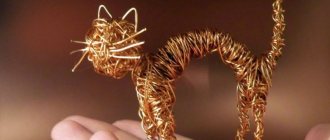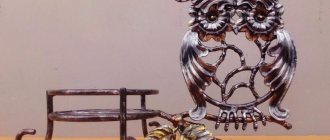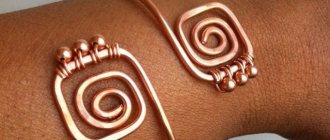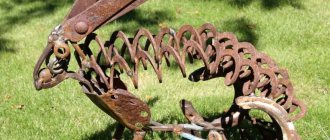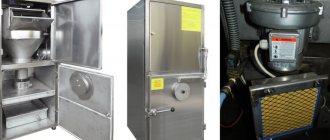Wire is sold in coils, and sometimes there are a lot of bent and twisted pieces lying around at home. But what to do if you need a piece - large or small - of perfectly straight wire? In industrial production, wire is straightened using special machines or using high temperatures. But what to do at home? FirstStroy.ru portal will tell you about simple and effective ways to straighten wire at home.
Home craftsmen have long come up with many ways to simply and cost-effectively straighten both wire from a coil and different pieces of wire - bent and twisted.
How to straighten a wire?
- Industrial methods
- How to straighten without a machine?
- Leveling at home
Sometimes when working in workshops or for domestic purposes, pieces of straight wire are required. In this situation, the question arises of how to straighten the wire, because when manufactured in factories, it is packaged in rounded coils - this shape is ergonomic, it facilitates storage and further transportation. To straighten steel, copper or aluminum wire, you should make some effort and use simple devices.
Types of wire
Wire surprises with its plasticity and great potential for use in the design of jewelry and decorative souvenirs. It is widely used to create costume jewelry. In rare cases, material is taken from noble metals. Basically, simple, inexpensive wire is used:
- copper;
- aluminum;
- costume jewelry, sold in creative goods departments.
Jewelry wire is created specifically for creative works. Its alloy contains metals that have valuable artistic properties - softness, strength, ductility, beautiful appearance. The cross-section has a round, semicircular or square shape. On sale you can find copper wire with a silver coating with a flat section, aluminum with a shiny coating. Aluminum creative material resists corrosion and negative environmental influences.
They also work with technical materials consisting of pure copper and stainless steel, but the process is complicated by the need to clean it of insulation.
Industrial methods
In production conditions, straightening machines are used as straighteners for all types of wire. The process itself is based on two basic techniques.
The first involves distribution by rolling through a block of 5-6 pairs of rollers, arranged in steps in different planes so that each subsequent one is perpendicular to the previous one.
The second method is based on straightening by drawing through a special die.
In most cases, such methods involve a specialized device that allows automatic unwinding of rods from coils.
If the technology features require the use of alloy steel rods or elastic varieties of wire, then preheating of the steel material will be required using high-frequency induction heaters or specialized gas burners.
Wire cloud
A cloud with wire rain looks interesting as a decorative item. The figure is simple, but surprisingly harmonious. The outline of the cloud has an oval, uneven shape, with light waves. At the bottom of the cloud outline there are long pieces of wire with drops formed at the end. The cuts represent rain.
There are many photos of wire products on thematic Internet resources. You can’t take your eyes off some of them; you want to make the same thing and decorate your home with it.
How to straighten without a machine?
At home, the wire is straightened for grounding, lightning protection and some other work. It is unlikely that in everyday life you can find a high-quality roller machine that can straighten wire with a cross-sectional diameter of more than 2 mm - it is expensive, and the process itself is quite labor-intensive. Purchasing special equipment also does not make any sense if the need to unwind the rod is one-time. Therefore, in order to straighten metal wire from a coil or coil, you can use the nodal tension method. For this purpose, a certain sequence of actions should be performed.
One end of the rod is firmly fixed to something bulky, heavy and solid. For example, they wrap it around a power pole or a strong tree with a trunk diameter of at least 25 cm.
After this, the wire is unwound on the ground by hand, stretching it as much as possible. A loop is formed from the other end of the wire unwound in this way and fixed in a device that can be pulled with great force - that is, this device must move a certain distance.
The straightening process itself comes down to slowly stretching a metal workpiece with maximum effort until its shape takes the form of an ideal string.
To secure the resulting straight shape, the wire must be left in this taut state for a short period - from 10 minutes to half an hour.
For such work, you can use a variety of devices - this directly depends on the parameters of the cross-section of the rod. So, for a product with a diameter of less than 2 mm, scrap steel, as well as the combined physical efforts of a couple of strong men, will be more than enough. And also in this case you can use a mechanical winch. But rods with a diameter of 5 mm and above will require much more significant effort - for this they use the dynamic force of a tractor, truck or tow bar of a passenger car.
Please note that straightening a wire with a diameter of more than 5 mm if it is made of alloy steel will require not only tension to the state of a string, but also subsequent stretching. It must be carried out until the rod bursts. Typically, a break occurs at the attachment site at one end of the string - at this moment it is better to be as far as possible from the stretched wire.
Making gold chains with your own hands
Gold chains are wonderful jewelry that is suitable not only for women, but also for men.
Learning how to make a gold chain with your own hands is a great idea for a jewelry maker. A gold chain is a luxurious piece of jewelry that attracts the attention of people around you, and for a jeweler, chains provide a wide scope for the embodiment of fantasies and creativity. It often happens that the chain breaks easily, although it does not look so fragile. It is impossible to even imagine that this chain can support the weight of a weight. Why does this happen? In this article we will try to understand and answer this question. To begin with, let’s take a general look at all the stages of making gold chains.
The jeweler takes a small bar of pure gold, which was obtained after refining. Separates the required amount and mixes it with the ligature. This is done to ensure that the gold chain is strong and durable. To obtain the necessary alloy for making a chain, you need to take 5.85 grams of pure gold, 2.92 grams of copper and 1.22 grams of silver.
We fuse all these metals in a crucible, sprinkle with borax, and be sure to stir. The melting point is about 950 degrees. After hardening, the hot piece of metal is cooled in water and boiled in bleach. As a result, we get 10 grams of 585 gold alloy, which indicates the percentage of gold in the product.
The higher the purity, the higher the pure gold content, but the much softer the alloy. Impurities of other metals not only impart hardness and strength to gold, but also change its color. By replacing the ratio of metals that make up the ligature, the required color for the future decoration is selected.
To make a chain, we pour gold into a mold and get a gold rod about 5 mm thick. In order to make a chain from it, you now need to burn it and stretch it to the state of a wire of the required diameter, which depends on the mass of the future product.
To do this, you need to pass our rod first through rollers, from a larger stream to a smaller one, and then through dies. When rolling on rollers, it is very important not to confuse the size of the strand, since if you put a gold rod into a strand of a smaller size, cracks will appear, and as a result, when pulled through dies, the wire will break and the future product will be of poor quality. When working with dies, it is necessary to lubricate the wire with the wax of a regular candle.
After completing the stage of making gold wire, the process of weaving the chain itself begins. First of all, the resulting gold wire is twisted into a spiral of the required diameter, then from the spiral, using special scissors, we cut links for the future chain. We weave the resulting links into a chain of the required length and solder them using solder. Next comes the process of polishing and installing the lock.
Soldering thin circuits
What about thin chains?
After all, small links cannot be soldered manually. What to do in this case? Typically, thin chains are produced on special machines, in large jewelry factories and factories. To solder the links, the chains are coated with a special powder, which is a mixture of solder and flux. This powder envelops the junction of each link, then the chains enter the muffle furnace, where the temperature ranges from 500-600 degrees. At this temperature, the gold itself simply glows while the solder melts, joining the joints. The chain is now strong and ready for further processing.
Leveling at home
Metal wire twisted into coils can conditionally be called smooth. To straighten it, you need to apply a small force to neutralize the curvature of the radius.
If you are dealing with broken remains of material, the task becomes much more complicated. Illiquid balances represent all sorts of zigzags, twisted in different directions from the axis.
However, even in this case, straightening the rods to an even state is possible. There are several effective methods for straightening wire - depending on the degree of complexity, they give different results at the output.
So, in order to straighten the creases on a metal wire, you need to fix both ends of it in your hands and roll it through a thick pipe or door handle with physical effort.
A good effect can be achieved if you place the curved sections on a workbench, then cover them with a wooden beam and start rolling it. This will allow the wire to move freely, and, as a rule, 4-5 such rolling will give the desired effect.
To straighten a copper wire, one end should be secured at a height, and a voluminous load of medium weight should be suspended at the other end - it should not tear the rod. This load must be rotated in a clockwise direction, and then back several times around its axis in each direction.
After 5-10 minutes you can achieve an almost perfect result.
A similar option: fix one side of the rod in a vice, and clamp the other side into the chuck of a drill or screwdriver . In this case, the distribution is carried out due to slow rotation while simultaneously holding the product in a state of strong tension - usually several revolutions are enough for final straightening.
You can also use a screwdriver or drill to straighten short pieces of wire - no more than 30 cm. To do this, in a small wooden block you need to make holes slightly larger than the wire itself and pass one end of the rod through it, fix the other in the chuck and begin to slowly rotate so that the rod was pulled through the hole.
If you have some working skills, you can make a very simple and at the same time budget hand tool with your own hands. You will need a wooden board with parameters 500x120x50 mm in a straight line with a slight indentation to the size of the wire diameter. 5-7 nails with a diameter of 4-5 mm are driven into it, the distance between them directly depends on the size of the workpiece and the degree of its elasticity - for thin wire the gaps should be smaller, for thick wire - larger.
Straightening is done by pulling the wire between the nails along a designated marking line.
See below for information on how to straighten the wire.
Materials and tools
Before mastering a new type of needlework, it is important to stock up on sufficient materials and tools. What may be useful at work:
- Wire of different structures and thicknesses (copper, aluminum, chenille wire of different colors, etc.).
- Foil, colored paper, shreds, colored threads.
- Plasticine of different colors or clay.
- Beads, sequins, beads.
- Decorative elements, dry twigs of different shapes
To create more complex crafts, you may also need diagrams, detailed instructions and drawings.
A basic set of tools that you will have to work with:
- You will need wire cutters for biting off the wire, round nose pliers or pliers for bending and twisting the material.
- Soldering iron and tweezers - for soldering thick copper wire (when creating copper jewelry). You will need tin, rosin and a little skill.
- A small hammer and anvil are useful for flattening individual parts of the craft.
- Sandpaper, fine-grained file.
- Scissors are necessary for cutting out elements from paper and fabric.
- Scotch tape or electrical tape - for temporarily connecting parts of the craft.
Simple ways to straighten wire at home
Sometimes in the process of repair and other work a perfectly straight wire in the form of a string is required. It is sold in rolls and can be stored rolled up. The RMNT website will tell you how you can straighten wire at home without using special industrial machines.
In industry, special machines are always used to straighten wire, as well as heating methods. At home, it is not practical to buy or make your own wire straightening machine. Most often, this is a one-time or rarely occurring need, so home craftsmen cope with the means at hand.
The easiest way to straighten wire from a coil without special tools looks like this:
- The end of the wire is tightly screwed onto something solid and massive. For example, on a power line pole, a metal fence pipe, or a strong tree.
- The coil is unwound manually and stretched to its maximum. Serious physical effort will be required!
- The second end of the wire, stretched to maximum tension, is also fixed to something that can gradually move. It is advisable to use a winch.
- The wire is straightened gradually, with great effort, until it turns into an even string.
- The wire must be left in a tense state for at least 10 minutes, or better yet for half an hour, so that it “remembers” the new shape and does not twist again after it is disconnected from the tension points.
Important! To stretch a wire with a diameter of more than 5 millimeters, physical effort alone may not be enough. You will have to use equipment, a tow bar of a car or a mini-tractor.
Important! If a wire with a diameter of more than 5 millimeters is made of alloy steel, it will need to be stretched until the string breaks. It is very important to follow safety rules and move away from the stretched wire.
The method described above is suitable for straightening wire from a coil. If you need to straighten small, twisted pieces, crumpled remains, you can use the following methods:
- Hold the wire with both hands and push it through a doorknob or wrap it around a pipe. And just roll the piece, leveling it thanks to tension and physical effort. The main thing is that the door handle or pipe can withstand such a load.
- Place a piece of wire on a workbench, press it down with a wooden block and roll it over the surface. The Rmnt.ru portal has already written about how to make a workbench for a garage with your own hands.
- Copper wire is soft. You can level it by simply attaching a weight that is not too heavy to the end so as not to tear it, and rotating it clockwise on the wire and back.
- Clamp one end of the wire in a vice, and the other in the chuck of an electric drill or screwdriver. You will need to slowly rotate the wire with the tool and keep it under tension the entire time. The main thing for you is to hold on for a few turns; this leveling method is very effective.
- Pieces of wire up to 30 centimeters long can be straightened by pulling them through a hole in a wooden block. The hole can also be made with a power tool, and the wire can be rotated in the hole with an electric drill, clamped in the chuck.
- You can practically make a machine for straightening pieces of wire by simply hammering nails in a row on a wooden block. The wire is manually pulled between the nails and aligned.
First steps
Wire-based products amaze with their beauty. I would like to join this art and also create something beautiful. However, in order not to encounter the beginner's disappointment syndrome, you need to start with simple crafts, gradually complicating them.
The first steps in weaving can be simple contours of animals, fantasy people, and various objects. For example, to make a simple Christmas tree, it is enough to bend the wire, why bend its halves symmetrically.
If you make blank rings, and then connect them in groups of three to five pieces with another ring, you will get a simple bracelet. A garland of rings will decorate a child's room. Children from preschool age and older are gladly involved in the work of creating wire products.
How to straighten wire at home
Sometimes neat wire rods of not very long length are required. How to align them quickly and perfectly without using a hammer? For such a case, there is a ready-made solution, which will be discussed in this video tutorial.
To make this homemade device, which will free you from the need to crumple the wire in your hands, trying to do the almost impossible, you will need a blank from a 70-gauge angle, three bearings and bolts with nuts for fastening the bearings. Two bearing units are installed stationary, and one can change position. This bearing is used to press the wire against two others during the pulling process. By changing the gap between the bearings, you can gradually narrow the space in which the wire will be located in this process.
How is alignment carried out?
A wire is inserted into the device, clamped in a vice, one end of which is clamped with a screwdriver. By pushing the rotating wire between the rollers and gradually clamping it between them, it is drawn and aligned.
Discussion
Vladimir Skorobogatov 3 years ago
Alexander, I’ve been making fishing floats from burdock cores for several years, they work great. For a river, it is better to put wire on the keel, but it is difficult to straighten a thin vein from a steel cable, maybe you can advise something. If you are interested, you can see the floats in classmates in the group: “homemade float and more.”
2 years ago
It was cool to watch the video and immediately straightened all the wire, with such success it would be faster to take it to the jewelry store for stretching. Since making your device will take much more time and money. I would call the video “Device for aligning wire”, but nothing like “how to quickly and easily align wire.” Because without such a device it is not fast or easy, and the essence of the video is precisely in the device.
Sometimes, for household needs or in the workshop, you need to use pieces of straight wire for work. But the question immediately arises: how to straighten the wire? After all, it is produced in factories and immediately packaged in round coils. This form is very convenient for storage and transportation. Therefore, in order to make a metal wire straight, it is necessary to expend not only some effort, but also use a number of simple devices.
Industrial methods
In production, specialized straight cutting machines are used to straighten almost all types of metal wire. The process is based on two main methods:
- straightening by rolling through a system of 5-6 pairs of rollers, which are located sequentially in different planes so that each subsequent pair is perpendicular to the neighboring one;
- straightening by drawing through several specially made dies.
As a rule, such machines must have a special device for automatically unwinding wire from coils or coils.
To work with elastic types of wire and alloy steel rod, the production technology involves heating and tempering the steel structure of the workpiece using gas burners or high-frequency inductive heaters.
How an industrial straightening and cutting machine works can be seen in the video:
How to straighten wire without a machine
Unfortunately, at home, making a good roller machine capable of straightening wire with a diameter of over 2 mm is quite expensive and labor-intensive. Moreover, if the need for a straight wire rod is one-time. An example of one of these devices can be seen in the photo.
Therefore, in order to straighten the metal wire from the coil, it is worth using the most common method of force stretching, for this you must be guided by the following sequence:
- First you need to firmly fix one end of the wire in something massive and solid. To do this, you can wrap its end around the base of a power line pole or a strong tree with a trunk diameter of at least 25 centimeters.
- Next, we manually unwind the coil on the ground and, if possible, stretch it as much as possible.
- At the second end of the unwound wire we make a loop and secure it in a device capable of pulling it with force, that is, moving it a certain distance.
- The straightening process itself consists of slowly stretching the metal wire with great force until it becomes shaped like an ideal string. To secure the straight shape, you can leave it in this tense state for some short time, from about 5 to 30 minutes.
Decorations
Making jewelry is a very interesting activity, but very labor-intensive. The craftsman must have significant experience and show maximum concentration in the process of making jewelry. First attempts do not always end in success.
When creating jewelry, beads are most often used. The beads are placed on a wire to create a bracelet with a unique design.
Craftsmen use copper to create unusual ethnic jewelry, in which stones or beads are inserted into the frame.
You can create any type of jewelry: earrings, bracelets, pendants, rings and brooches. A variety of weaving techniques, adding bright stones and other decorative elements allows you to create almost any decoration for all occasions.
How to straighten thick wire quickly and easily
How to straighten thick wire
Thick steel wire (wire rod) is used for various purposes; it is used to strengthen poles and is used for welding metal structures. Very often you have to straighten a thick wire, however, given its rather large diameter, this is quite problematic.
This article from the construction magazine samastroyka.ru will tell you how to quickly straighten thick wire at home.
What you need to straighten the wire
Aligning steel wire with a diameter of 4-6-8 mm is not so easy. This is especially difficult to do at home, where often there is nothing at hand except a hammer and a vice. But still, if you try, you can quickly carry out this procedure without resorting to any specialized means.
So, to align thick wire, we will need:
- A small piece of log (50 cm long);
- Electric drill;
- Long wood drill. It is very important that the diameter of the drill be slightly larger than the diameter of the steel wire that needs to be aligned. Also, the length of the drill must be sufficient to make a through hole in the log;
- Winch.
As for the winch, it can be replaced with a car. The point is to create a pulling force to straighten the thick wire, since doing this by hand will be impossible.
How to straighten thick wire
Let's look at the step-by-step process of straightening wire with a diameter of 4-6 mm at home:
First, take a small piece of log, and closer to the edge, drill a through hole in it. As mentioned earlier, the hole should be such that the wire can easily fit through it.
We will tie a cable to the other end of the log with ties, which will need to be hooked to the post. During the alignment process, the wire will be pulled through the log. Therefore, the support to which the cable is fixed must be quite reliable.
Then we will pass the end of the wire through the log and connect it to the winch. If you don’t have a winch at hand, you can throw a wire on a car tow bar. To do this, the end of the wire is pulled into a loop or an ear clamp like this is made by welding.
When everything is securely fastened, you can begin to align the wire. To do this, the wire is pulled through a hole in the log at a slight angle. As a result, the thick wire will be almost perfectly smooth, and it can be conveniently used in work.
It is simply impossible to straighten thick wire of sufficient length, for example, using a hammer. But, with such a simple device, you can always straighten a thick wire without putting in a lot of effort and a lot of time.
Angel made of wire and beads
A wire angel with beads intertwined looks gentle and airy. For work, take thin and thick wire. A frame is created from thick wire material. Blue beads are strung on a thin wire to fill the outline of the body, red beads are used to fill the neck and arms, and white beads are used to fill the wings and a halo above the head. The craft turns out to be sophisticated and elegant. There is no shame in giving it to friends and family for New Year or Christmas.
How to Manually Align and Straighten Wire
Sometimes, for household needs or in the workshop, you need to use pieces of straight wire for work. But the question immediately arises: how to straighten the wire? After all, it is produced in factories and immediately packaged in round coils. This form is very convenient for storage and transportation. Therefore, in order to make a metal wire straight, it is necessary to expend not only some effort, but also use a number of simple devices.
Industrial methods
In production, specialized straight cutting machines are used to straighten almost all types of metal wire. The process is based on two main methods:
- straightening by rolling through a system of 5-6 pairs of rollers, which are located sequentially in different planes so that each subsequent pair is perpendicular to the neighboring one;
- straightening by drawing through several specially made dies.
As a rule, such machines must have a special device for automatically unwinding wire from coils or coils.
To work with elastic types of wire and alloy steel rod, the production technology involves heating and tempering the steel structure of the workpiece using gas burners or high-frequency inductive heaters.
How an industrial straightening and cutting machine works can be seen in the video:
How to straighten wire without a machine
Unfortunately, at home, making a good roller machine capable of straightening wire with a diameter of over 2 mm is quite expensive and labor-intensive. Moreover, if the need for a straight wire rod is one-time. An example of one of these devices can be seen in the photo.
Therefore, in order to straighten the metal wire from the coil, it is worth using the most common method of force stretching, for this you must be guided by the following sequence:
- First you need to firmly fix one end of the wire in something massive and solid. To do this, you can wrap its end around the base of a power line pole or a strong tree with a trunk diameter of at least 25 centimeters.
- Next, we manually unwind the coil on the ground and, if possible, stretch it as much as possible.
- At the second end of the unwound wire we make a loop and secure it in a device capable of pulling it with force, that is, moving it a certain distance.
- The straightening process itself consists of slowly stretching the metal wire with great force until it becomes shaped like an ideal string. To secure the straight shape, you can leave it in this tense state for some short time, from about 5 to 30 minutes.
A fairly wide range of devices can be used as a tensioning device, depending on the diameter of the metal wire. So, for a wire 2-3 mm in diameter, a steel scrap with the effort of two strong men or the use of a manual mechanical winch may be enough. But straightening wire for a diameter of 5 mm or more will require much significant effort and for this you will need to use either the towbar of a personal car, or the dynamic force of a tractor or truck.
It is worth keeping in mind that straightening a wire with a diameter of more than 5 mm, made of alloy steel, will require not just tension to the shape of the string, but stretching until the wire breaks. As a rule, the rupture occurs at the attachment point on one of the ends, and for safety reasons you should not be near the stretched wire.
Working techniques
- Various weaving techniques help create a wide variety of products. Among the variety of methods for working with wire, several basic techniques can be distinguished:
- Decorative weaving with the addition of beads and bugles. You can create various interesting crafts from beads and wire. Unlike fishing line, which can break, the wire base holds its shape well and bends well in any desired direction.
- The technique of twisting in the form of a spiral and other curls allows you to make unique products. The emergence of this twisting technique gave impetus to jewelry delights. They began to weave expensive jewelry and luxury items from silver and gold wire.
- Ganutel involves mixing wire with silk threads to create a variety of flower crafts using pearls, beads, rhinestones or precious stones.
- The filigree technique makes it possible to produce openwork interior items and decorations.
Experienced craftsmen can sometimes use several techniques in their work to make one product. They specifically use this solution. The important thing here is not to overload the result in the end.
What you need to straighten the wire
Aligning steel wire with a diameter of 4-6-8 mm is not so easy. This is especially difficult to do at home, where often there is nothing at hand except a hammer and a vice. But still, if you try, you can quickly carry out this procedure without resorting to any specialized means.
So, to align thick wire, we will need:
- A small piece of log (50 cm long);
- Electric drill;
- Long wood drill. It is very important that the diameter of the drill be slightly larger than the diameter of the steel wire that needs to be aligned. Also, the length of the drill must be sufficient to make a through hole in the log;
- Winch.
As for the winch, it can be replaced with a car. The point is to create a pulling force to straighten the thick wire, since doing this by hand will be impossible.
Diamond shape
The armored type of weaving has polished links located in the same plane. Interlocking loops have a rhombic shape and can be connected with one, two or even three links at a time. There are various combinations of armor weave. For example, small links are woven into large ones or sequentially alternate with each other. The first species is called "Nonna", the second - "Figaro". Another weaving method, which can have a square, oval or round cross-section, is called “Snake” or “Cobra”. Indeed, the cord in appearance resembles a snake’s shell and is slightly curved. Rope chain weaving also belongs to the armored type. When connecting the links, the chain rotates slightly in a certain direction, resembling a rope in appearance.
How to straighten a wire: a homemade device
Sometimes neat wire rods of not very long length are required. How to align them quickly and perfectly without using a hammer? For such a case, there is a ready-made solution, which will be discussed in this video tutorial.
To make this homemade device, which will free you from the need to crumple the wire in your hands, trying to do the almost impossible, you will need a blank from a 70-gauge angle, three bearings and bolts with nuts for fastening the bearings. Two bearing units are installed stationary, and one can change position. This bearing is used to press the wire against two others during the pulling process. By changing the gap between the bearings, you can gradually narrow the space in which the wire will be located in this process.
How is alignment carried out?
A wire is inserted into the device, clamped in a vice, one end of which is clamped with a screwdriver. By pushing the rotating wire between the rollers and gradually clamping it between them, it is drawn and aligned.
Wire flowers
Like any creative activity, working with wire material develops children’s motor skills, memory, ability to logic, fantasy, imagination, perseverance, introduces them to creativity, and helps them understand the world around them.
A thin wire is suitable for children's hands; it is easy to bend and deform. At the beginning of work, a flower with a stem is drawn on paper; during the work process, the blank is applied to the template for comparison. To strengthen the stem, it is wrapped with a double fold of wire. The center of the flower is a ring, the petals are wire wrapped around the ring in waves.
Gromovod
- - accessible and inexpensive
- — quick installation
- - always in stock
- — quick registration
- — discounts from 5 days
- - folding tripod base
- - one person management
- - ease of use
- - light and durable
- — buying as a set is cheaper!
- - alignment of wire in coils
- — electrolytic galvanization Fe/Zn12/C/T2
- - control both manually and remotely
- — bearings do not require lubrication
- — thermal protection of electric motors from overload
A truly reliable device that has never let me down. And believe me, we have enough work for him.
The price won him over. Or more precisely, value for money. So far it hasn't let me down, it works fine.
There were fears at the beginning, but completely in vain. A normal workhorse. The further it goes, the more it makes our work easier.
Still have questions? Just leave your number to receive a free consultation. Or call right now! We are available on Whatsapp, Viber and Telegram.
sea anchor
With the anchor method, the connected links interlock with each other at an angle of 90 0. The loops of a classic chain are oval shaped. This is the simplest weaving method that you can use to make a chain with your own hands. If there is a crossbar between the links, then the weaving is called “Sea Anchor”. There is a coupling of not only narrow, but also wide rings - rollo or chopard. Venetian weaving differs from classical weaving by links that can take the shape of a square or rectangle. One block can contain several elements.
Weaving chains with your own hands
A product woven using the Viking Knit method is made of soft wire and does not require soldering. When weaving a chain around the neck, the material used is increased.
Before work, you need to prepare a pencil that will serve as a support, thin copper wire, scissors and a ruler. Weaving begins with preparing the base for the chain. Cut about 40 cm of copper thread and wrap it around the ruler, making 6 turns. Remove the resulting loops from the tool and secure them by wrapping them with the short end of the wire. Move the petals in different directions and place them on the blunt side of the pencil, bending them along the support. Start weaving with a new piece of copper thread 80 cm long. Make a loop by threading the wire through one of the warp petals. Then, turning the pencil, insert the upper end of the thread inside the next petal, bringing it out on the left side. In this way, tie loops around the entire base.
The new row begins with the girth of the loop of the previous circle. Then weaving continues in the same way until the working wire runs out. Twist the tip of the new piece of thread with the previous remainder and continue weaving to the required length. Subsequently, this tip will be hidden in the work. Please note that at the end of the work the chain must be stretched. Its length will almost double.
Using the methods discussed above, both men's and women's chains can be woven. By learning to make jewelry, you will gain good experience with metal and learn basic jewelry making skills.
